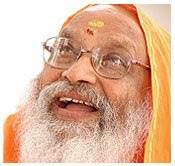Tuesday, June 10, 2014
Wednesday, August 14, 2013
Monday, August 13, 2012
A loving second home!
Young boys pick drumstick at the garden they look after at the AIM for Seva student home in Anaikatti
Computer lab at the girls' home
Chhatralayas for tribal children across the country aim to give them a better chance in life.
Eight-year-old Krishnadas no longer needs to travel 14 km through dense jungle to get to school every day.
Savithri, who used to study by the light of dim oil lamps, now has access to electricity from solar power.
Nandakumar, the son of a railway porter, dreams of becoming an IAS officer.
It is late evening. Several girls are busy studying in a typical South Indian style courtyard surrounded by rooms. The walls are decorated with colourful paintings done by them, and their mattresses and personal effects are neatly stacked inside the rooms. There is a sense of cleanliness and discipline.
This is the scene in a chhatralaya, or student’s home, for tribal children in Anaikatti near Coimbatore, run by AIM for Seva, an initiative of Swami Dayananda Saraswati of Arsha Vidya Gurukulam. The first chhatralaya was started in 2000. Today, there are 90 chhatralayas in 14 States across the country, from Karnaprayag to Kanyakumari. They are supervised by well-trained people with a passion for serving the needy.
With a twinkle in his eye, Swami Dayananda Saraswati recalls the incident that sparked off the project: “We were constructing a water pipeline from the forests to the plains for the local people when a tribal woman mentioned that it was impossible for their children to come to school as they had to travel a long distance through the jungle, which swarmed with elephants. This was the trigger which made us start the All India Movement for Seva.”
The very first chhatralaya was, in fact, set up in Anaikatti. It was a single-storeyed student’s home, accommodating 100 boys studying from second to twelfth standard. Another one was soon built for girls.
“Most of our young ones are first-generation school goers,” says Velumani, the warden of the boy’s home, “and required some guidance. In spite of my NGO background, it took me a while to learn how to work with them. Now I am enjoying the work.”
Typically, the children’s day starts at 5 a.m., and in an hour they are ready for prayer, followed by breakfast and study time. They are off to school by 9 a.m., and return around 5 p.m. After evening prayers, they sit for studies and go to bed at 9 after a healthy and sumptuous dinner.
Who takes care of the daily maintenance of these chhatralayas? The children themselves. As Bhagyam, the warden of the girl’s home, explains, “They do the cleaning, wash their own clothes and vessels, and help in the kitchen to cut vegetables. This helps them become more responsible and independent. There is a group leader for every standard who helps the other students.”
“All the akkas take good care of me,” says little Sindhu Bharati, 8, the youngest in the Anaikatti girl’s home. “They help me in washing my clothes, and doing my hair. I am learning a lot from them.” She has been here for three years.
Clarifying this arrangement, one parent explained, “My daughter seldom falls sick and likes engaging herself in all the activities.”
Surrounded by hills, both the chhatralayas offer a scenic view, and have enough open space to grow vegetables. As all the children are trained in gardening as a part of vocational training, the garden is a busy place. Fourteen-year-old Nandakumar proudly points out, “We have grown and maintained jackfruit trees, gooseberry trees and onions.” The girls grow tomato and lady’s finger in their garden. The girls get tailoring lessons as well.
Equipped with 14 computers, the home ensures that the children also acquire a basic knowledge of computers. “Twelfth standard students who have taken computer science in school teach the others about its use in our computer lab,” says Velumani. “A few volunteers from outside also come and help them,” adds Bhagyam.
There are plenty of other activities on offer. While there are classical dance, music and sloka classes, the air also reverberates with the sound of foot-thumping tribal dances accompanied by tabla, drums and harmonium, all played by the children. “Every year we have a cultural programme where the girls and boys showcase their talent in music and dance,” says Bhagyam.
The AIM for Seva movement receives financial support from the NRI community, and some individuals within India, but more aid will make it possible to implement the larger vision they have. Swami Dayananda Saraswati says he would like to establish chhatralayas in every district of the country, as children in many parts of the country do not have access to education. The need is very high, he says and is hopeful of making it a reality.
“We have approached government departments, private entities and corporate sectors for funds,” says Sheela Balaji, secretary of the AIM for Seva movement. “We hope they will come forward and support us.”
With dedicated members and more likeminded individuals contributing to the cause, the long-term vision of the programme appears promising.
Monday, June 4, 2012
LeHigh holds an AIMS walkathon!
Yesterday (June 3rd) we had our 3rd Lehigh Valley Walkathon. Attached are lots of pictures. We had the pleasure of Mr. Charlie Dent, US Congressman, Mr. Ed Pawlowski, Mayor of Allentown amongst others. It was a successful event.
We hope to continue this as an Annual Fun event to raise awareness, create excitement and raise funds.
Best wishes,
LeHigh Walkathon Team
Friday, June 1, 2012
USA Fundraiser 2012
Coming to a city near you... AIM For Seva Fundraiser 2012
(Click on Links for more details)
Rukmini Vijayakumar and party
-- Quick profile (Rukmini's web-site)
-- Wikipedia
-- Raadha Kalpa
-- NY Times article
-- Video
-- YouTube
-- Rukmini on Facebook
-- KollyTalk interview - Role as Rajnikant's sister in filmKochadaiyaan
Thursday, February 9, 2012
Life of a visionary
Unravelling the life of a visionary
Feb 08, 2012, DHNS:
Personal Experiences
A group of people came together for an evening recently at the Bangalore International Centre. The cause this time wasn’t a social one alone.
 The All India Movement for Seva (AIM) launched the biography of its founder Dayananda Saraswati by author and follower Sheela Balaji.
The All India Movement for Seva (AIM) launched the biography of its founder Dayananda Saraswati by author and follower Sheela Balaji.
‘Swami Dayananda Saraswati - Contributions and Writings’ is a piece of non-fiction and attempts to capture the life of the man, his early days, the start of his social empire and his teachings on Vedanta. The book was aptly released in celebration of the 80th birthday of Dayananda Saraswati.
Author Sheela Balaji, who has been with AIM since 2003, has many a personal experience to narrate through the pages. “When talking about Swamiji to someone, I had practically no literature to give away. Many people would mistake him for the Dayananda Saraswati who started Arya Samaj.
The last book written on him was published 22 years ago and is out of print,” says Sheela. “He has been one of the game changers in my life and a book that gave a full picture on him, being released in the year of Satabhishekam (80th birthday), seemed a good idea,” she adds.
The book was launched by Dileep Rajnekar, CEO, Azim Premiji Foundation and B Mahadevan, Professor, Indian Institute of Management Bangalore. Both the guests spoke of their views of Dayananda Saraswati and his contribution to the field of education. Sheela gave a small speech on her experiences while writing the book and anecdotes that talk about the man’s greatness.
 The All India Movement for Seva (AIM) launched the biography of its founder Dayananda Saraswati by author and follower Sheela Balaji.
The All India Movement for Seva (AIM) launched the biography of its founder Dayananda Saraswati by author and follower Sheela Balaji. ‘Swami Dayananda Saraswati - Contributions and Writings’ is a piece of non-fiction and attempts to capture the life of the man, his early days, the start of his social empire and his teachings on Vedanta. The book was aptly released in celebration of the 80th birthday of Dayananda Saraswati.
Author Sheela Balaji, who has been with AIM since 2003, has many a personal experience to narrate through the pages. “When talking about Swamiji to someone, I had practically no literature to give away. Many people would mistake him for the Dayananda Saraswati who started Arya Samaj.
The last book written on him was published 22 years ago and is out of print,” says Sheela. “He has been one of the game changers in my life and a book that gave a full picture on him, being released in the year of Satabhishekam (80th birthday), seemed a good idea,” she adds.
The book was launched by Dileep Rajnekar, CEO, Azim Premiji Foundation and B Mahadevan, Professor, Indian Institute of Management Bangalore. Both the guests spoke of their views of Dayananda Saraswati and his contribution to the field of education. Sheela gave a small speech on her experiences while writing the book and anecdotes that talk about the man’s greatness.
Wednesday, February 8, 2012
Subscribe to:
Posts (Atom)











